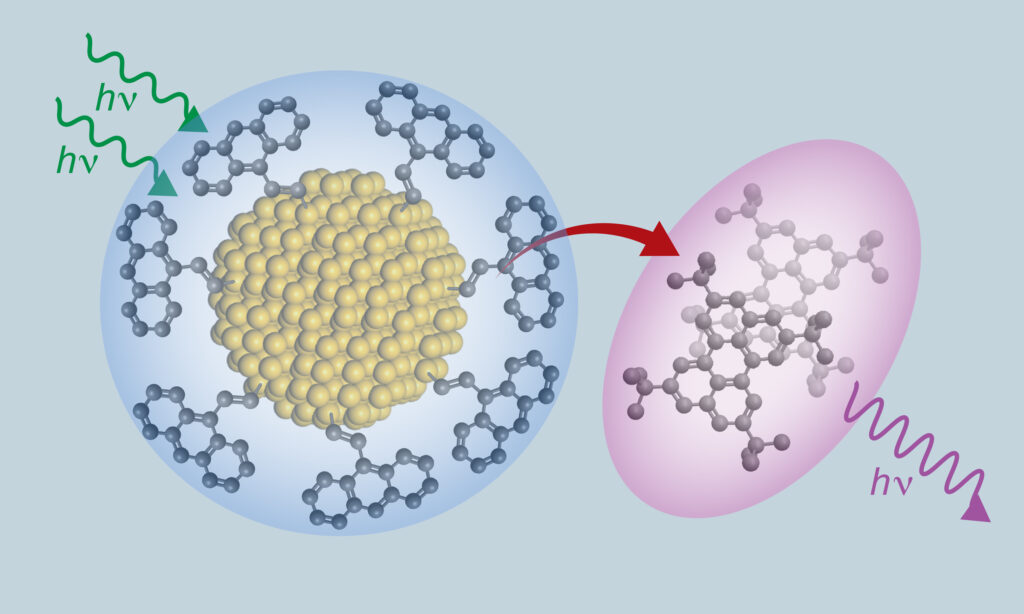University of California, Riverside (UCR) researchers have designed a composite material that offers powerful photon upconversion capabilities and that could support a range of light-driven applications as a result. The composite is made from silicon quantum dots and the organic molecule anthracene, which is used in OLED emissions. Anthracene’s unusual properties enable it to convert lower-energy light into higher-energy light.
Applications for the composite span the treatment of cancer to boosting photovoltaic efficiency.

The efficiency of solar panels could be increased by incorporating a newly developed composite material. Researchers designed the composite around the properties of the molecule anthracene, enabling the conversion of lower-energy wavelengths into higher-energy light. Courtesy of UT Austin.
The UCR lab is led by professor Lorenzo Mangolini, who helped invent the process to make these silicon nanoparticles. Team members include researchers at the University of Texas at Austin (UT Austin), the University of Colorado Boulder, and the University of Utah, in addition to the UCR group.
When hybrid structures are formed from organic and inorganic materials, the disparate properties of the materials can generate unusual photophysical transformations. However, according to the researchers, the electronic coupling that results between these materials is typically weak. This leads photoexcited charge carriers to spatially localize to the dot or to a molecule at its surface.
“We now know how to take two extremely different substances and bond them strongly enough to create not just a mixture, but an entirely new material with distinct properties,” said UT Austin professor Sean Roberts.
To create the material, the researchers converted a chemical linker, which can covalently bind anthracene molecules to silicon quantum dots, from a carbon-carbon single bond to a double bond. This step made it possible to access a strong coupling regime with the material, where excited carriers spatially delocalized across both the anthracene and silicon.
By pushing the system to delocalize, the researchers were able to design a photon upconversion system with a higher efficiency (i.e., 17.2%) and lower threshold intensity (i.e., 0.5 W/cm−2) than that of a corresponding, weakly coupled system.

A composite made of small silicon quantum dots and organic molecules can convert low-energy photons into higher-energy ones. The development supports applications including cancer treatments and bioimaging. Courtesy of UT Austin.
With this work, the researchers demonstrated that it is possible to direct a material to emit light with higher energy than the energy wavelength aimed at the material, through the process known as photon upconversion.
According to Mangolini, the newly designed material improves on the researchers’ previous attempts to create something that efficiently exchanges energy between two components that are dissimilar. “There are great opportunities to use this for a wide variety of applications, but perhaps one of the most important, from a human health perspective, is for cancer,” he said.
For example, high-energy light, such as ultraviolet (UV) laser light, can be used to form free radicals that attack cancer tissue. However, UV light does not travel deeply enough into tissues to generate therapeutic radicals near the tumor site. In contrast, near-infrared (NIR) light can penetrate deeply into the body, but it does not have enough energy to generate the cancer-killing radicals.
Through its ability to change low-energy light into a higher-energy form, the new material could enable both the generation and the delivery of the free radicals for treating tumors. In addition to being efficient, the silicon nanoparticles that form the base of the new material are nontoxic.
A similar approach could be used to improve the efficiency of solar cells. The researchers’ material would allow solar cell arrays to capture NIR light, a wavelength that normally passes through the arrays. According to the researchers, when the technology is optimized, capturing low-energy light could reduce the size of solar panels by 30%.
“These cells usually don’t use low-energy photons, but using this system, you could,” Mangolini said. “We could make the arrays much more efficient.”
Other applications that the composite material could support include bioimaging, light-based 3D printing, and light sensors for self-driving vehicles.
The research was published in Nature Chemistry (www.doi.org/10.1038/s41557-023-01225-x).